
Euphorbia is a very large and diverse genus of flowering plants, commonly called spurge, in the family Euphorbiaceae. "Euphorbia" is sometimes used in ordinary English to collectively refer to all members of Euphorbiaceae, not just to members of the genus.
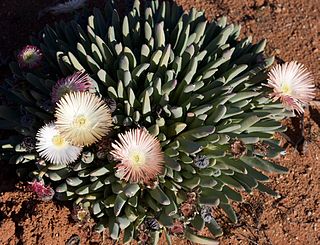
Cheiridopsis is a genus that consists of 100 species of flowering succulent perennial plants, native to semi-arid regions in the far west of Namibia and South Africa.
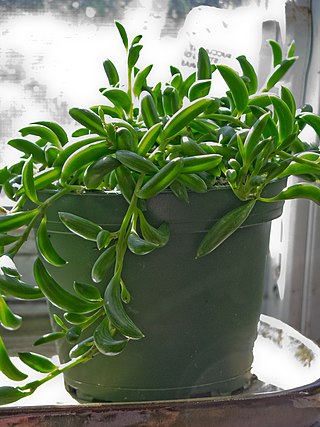
Curio radicans, syn. Senecio radicans, is a succulent houseplant that is native to Southern Africa. A member of the family Asteraceae, the asters, this species is closely related to the common string of pearls and Curio hallianus. It has multiple tendrils of glossy, banana-shaped foliage. It is commonly known as string of bananas or fishhook senecio.

Cheiridopsis denticulata is a species in the genus Cheiridopsis native to South Africa. It has yellow flowers, and distinctive foliage with a narrow, upward curving shape. Commonly called "pink fingers", the leaves grow in opposite pairs and are light blue with sun exposure blushing them shades of pink and purple.
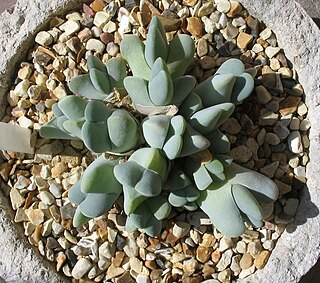
Cheiridopsis pillansii is a species of plant in the genus Cheiridopsis native to South Africa. It is a low-growing succulent with pairs of small, cushion-like leaves that are pale green to purple in color. C. pillansii, sometimes commonly called the "hoof mesemb", forms clumps up to 500 millimetres (20 in) wide.

Haworthia mutica is a species of succulent plant native to South Africa's Cape Province. Very similar to, and often confused with, types such as Haworthia retusa, the species has blunt, triangular shaped leaves that are typically striated. In the wild it rarely offsets, though clones in cultivation may do so readily. The variety H. mutica var nigra is similar but with darker leaf color.

Haworthia lockwoodii is a species of succulent plant in the genus Haworthia. Native to the Cape Province of South Africa, it was named for a local magistrate.

Haworthia floribunda is a species of succulent plant in the genus Haworthia native to the Cape Province of South Africa. It grows in rosettes with dark green, lanceolate leaves that curve or twist outward. The leaves may be smooth or, in H. floribunda var. dentata, have small teeth.
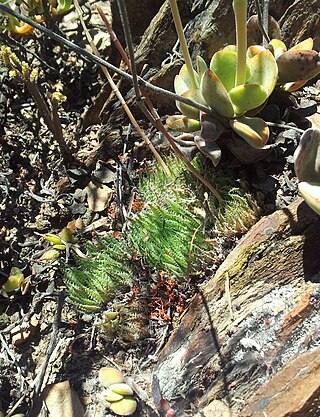
Haworthia herbacea is a species of succulent plant in the genus Haworthia native to the Cape Province of South Africa. Closely related to Haworthia reticulata, it has greenish yellow leaves with small spines. As it matures the leaves get darker green and the white spots raise. Flowers by way of a shoot and produces a large off-white flower.
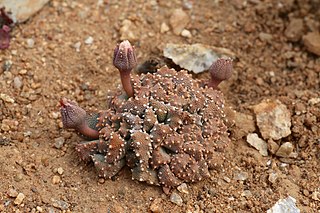
Aloinopsis luckhoffii is a species of succulent plant in the genus Aloinopsis native to South Africa. Like other Aloinopsis it grows in a rosette of leaves close to the ground. It has angular leaves that are covered by small, white tooth-like protrusions.
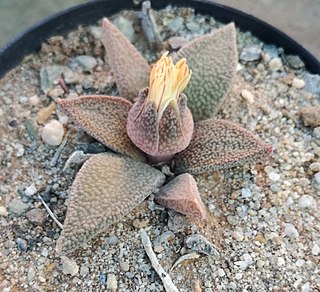
Aloinopsis rubrolineata is a species of succulent plant in the genus Aloinopsis native to South Africa. It grows in a branching habit low to the ground, and has leaves covered with small, round tubercles. The leaves are dark olive green and tongue-like in shape. Its scientific name refers to its flowers, which have a distinctive red stripe.
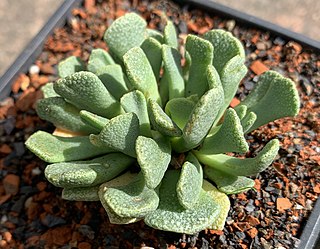
Aloinopsis spathulata is a species of succulent plant in the genus Aloinopsis native to South Africa. It has spoon-shaped green leaves patterned with tubercles, and unlike the yellow flowers of most in its genus, it has magenta to pink blooms. Able to grow in Sutherland, the coldest town in South Africa, it is particularly frost hardy.
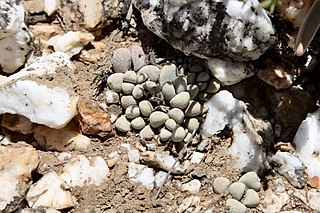
Crassula tecta is a species of succulent plant in the genus Crassula native to South Africa. Easily confused with Crassula namaquensis, this species has a compact growth habit forming clusters of round, blue-white leaves. Kept in cultivation since the 18th century, Crassula tecta is known for the beautiful patterning on its leaves and white flowers.
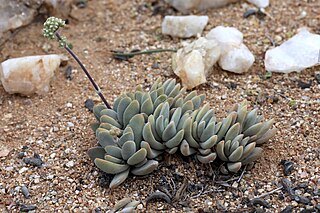
Crassula namaquensis is a species of succulent plant in the genus Crassula native to South Africa. Easily confused with some forms of Crassula tecta and Crassula sericea, this species has rounded to elongated leaves that are usually blue, covered in fine hairs, and form clumps.

Haworthia reticulata is a species of succulent plant native to the southwestern Cape Provinces of South Africa. The species has several varieties, including var. hurlingii which is the smallest at up to 1 inch (2.5 cm) wide.

Dracaena hallii is a species of succulent plant native to Mozambique, Zimbabwe, and Limpopo Province of South Africa. The species was named for Harry Hall, formerly the curator of succulents at Kirstenbosch National Botanical Garden in Cape Town. Commonly known as the "baseball bat" plant, it has extremely thick foliage with a rounded shape and a central channel.

Cheiridopsis speciosa is a species of plant from South Africa.
Cheiridopsis turbinata is a succulent plant from South Africa.
Cheiridopsis ponderosa is a species of succulent plant from South Africa.

Dracaena singularis is a species of succulent plant in the genus Dracaena native to Ethiopia, Kenya, and Tanzania. Mistakenly placed in the genus Boophane at first, by the 1980s the plant was corrected to be in the genus Sanseviera, until that entire genus was merged with Dracaena. The species is named singularis since at its mature size, it has only a single leaf up to 1.8 metres (5.9 ft) in length, while in a juvenile state it displays small rosettes of several leaves.


















